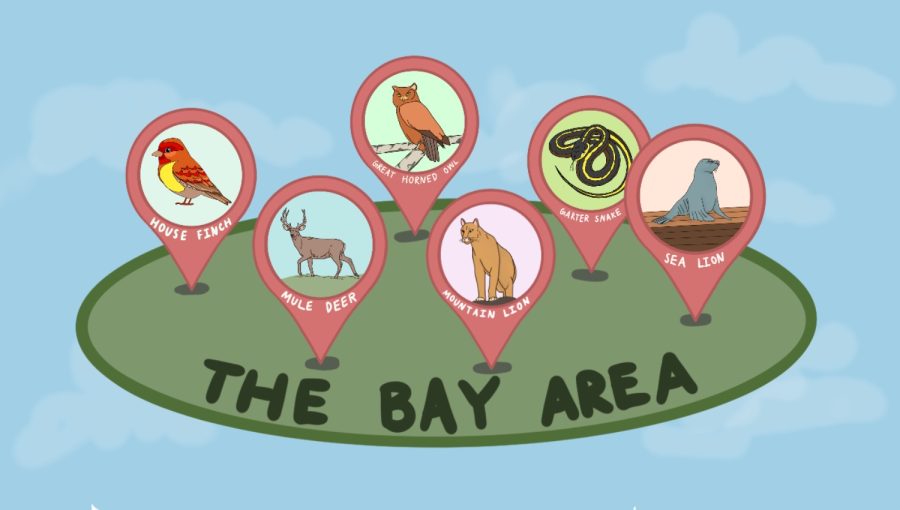The Bay Area: A hub of wildlife
Graphic illustration by Anwen Huang and Neha Ayyer
The Bay Area is home to a myriad of wildlife, from mountain lions to snakes to sea lions.
October 6, 2021
California sea lions, great horned owls, harbor porpoises, Canada geese, western gray squirrels — from the depths of the San Francisco Bay to the peaks of the Santa Cruz Mountains to Lynbrook students’ backyards, the Bay Area is home to a myriad of wildlife.
The Bay Area hosts many ecosystems of diverse flora and fauna. Close to the ocean, coastal grasslands are nourished by the sea breeze and stay green until midsummer, while inland grasslands are much drier and contain a diverse range of plant communities. In the coastal range and the central valley, oak woodlands line creek beds. The Northern coastal scrub, an ecosystem found near the coast, consists mainly of bushes, poison oak and berries. Additionally, the Bay Area wouldn’t be the Bay without its aquatic regions: the lakes, marshes and Pacific Ocean. These habitats allow the Bay Area to support nearly 500 species of mammals, birds, fish, amphibians and invertebrates.
“We’re fortunate here in California to have some of the most beautiful open spaces, and we have a really diverse range of different environments and habitats that are very close to the Bay Area,” Environmental Science teacher Bev Baller said. “Obviously the coastline and the marine ecosystem here in the San Francisco Bay is incredible, but within just several hours drive, you have the forest of the Redwoods, the mountains of the Sierras and the deserts of Southern California.”
The most frequently seen wildlife in the Bay Area can be found in a typical backyard: squirrels, raccoons and crows. The house finch, a small songbird, is the most common bird out of more than 600 bird species in California. Less common birds, like the California quail and the bald eagle, can be observed in the woodlands and lakes, respectively. In county, state and national parks, hikers occasionally spot black bears, mountain lions and mule deer. Commonly found in the Central Valley, the garter snake, the most prevalent of the 23 reptile species in California, slithers about.
The coast is home to many different species of marine wildlife. California sea lions, which are commonly spotted at Pier 39, can also be found in coastal parks. Harbor seals and waterfowl reside in marshy areas such as the Don Edwards San Francisco Bay National Wildlife Refuge. Along the coast, great white sharks and a variety of whale and dolphin species, including gray whales, humpback whales and common dolphins, can be observed.
“Whales have always been one of my favorite marine animals because they’re really big and you never see any living thing of this size anywhere else in the world,” Marine Wildlife Club Vice President Hank Hsu said.
Unfortunately, these diverse habitats and wildlife are threatened by climate change and other anthropogenic influences. On the coasts, warmer temperatures are causing various problems, such as rising sea levels and the “Pacific Blob,” an event in 2013 and 2019 when a large area of the Pacific Ocean developed unusually high temperatures. Due to warm waters, krill and crustaceans, major food sources for many marine animals, are unable to survive until adulthood. Other species, such as salmon, become stressed and more prone to disease at warmer temperatures. Ocean acidification, plastic pollution and sewage runoff are also human activities that are negatively impacting the oceans and their wildlife.
“Pollution is a big issue,” Baller said. “When we put pollutants in the environment and the animals ingest them, it’s not just hurting the animals. It’s also going to come through into our food sources and hurt us eventually.”
On land, increased summer temperatures have resulted in less fog, endangering species that prefer cooler weather. Additionally, less precipitation has reduced vegetation growth and disturbed food chains. Recently, countless animals have lost their habitats to wildfires and urbanization.
Fortunately, there are ways for students to help protect the Bay Area’s diverse wildlife. Students can restrain from feeding wild animals, since human food doesn’t fit in their diet; the animals will become reliant on humans, rendering them incapable of finding or hunting for their own food. Other simple acts include picking up litter on the ground, avoiding plastic products and using eco-friendly alternatives. For those who are passionate about nature, volunteering and educating others about the environment can go a long way in preserving and improving the beauty of local ecosystems.
“At the end of the day, harming wildlife does go back to affect us, the animal cycle and ecosystem cycle,” Animal Services and Protection Club officer Maple Leung said. “We are the ones harming them and taking their habitats. The least we can do is to learn and educate ourselves about how we can protect them.”





























































